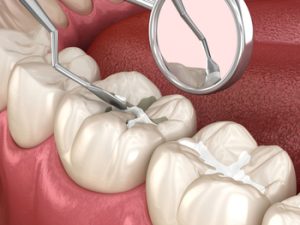If you’re looking for an easy way to protect your teeth or your child’s teeth from decay, the fissure sealant procedure might be just what you need. This preventive dental treatment is especially effective for molars that have deep grooves and pits on their surface, which are prone to trapping food and bacteria. But what exactly is a fissure sealants procedure, and how does the treatment work? Let’s take a closer look.
Tiny Coatings, Big Protection: The Power of Fissure Sealants
Fissure sealants, also called dental fissure sealants, are a protective coating made from a special plastic material. Dentists apply this coating to the chewing surfaces of the back molars, where deep grooves and pits, known as fissures, commonly occur. These fissures are so narrow that even a toothbrush bristle can’t reach the bottom of them properly, making them a hotspot for plaque and food particles that can cause tooth decay.
By covering these grooves with sealant, the surface of the tooth becomes smoother and easier to clean. This helps prevent bacteria from settling in and causing tooth decay. The treatment is suitable for both children and adults, but it’s especially beneficial for kids whose adult molars have just come through.
When Is the Best Time to Get Fissure Sealants?
Dentists often recommend the procedure during a regular checkup if they notice that the molar teeth have grooves that are hard to clean. It’s a proactive approach to oral health and helps avoid more serious problems down the line.
Let’s Talk About the Fissure Sealants Procedure
The fissure sealant procedure is quick, simple, and completely comfortable. It usually takes just one appointment and doesn’t require any anaesthetic. Here’s what typically happens:
1. Cleaning the Tooth Surface
To begin, the dentist will carefully clean and polish the surface of the tooth to eliminate any plaque or leftover debris. This is an important step to make sure the sealant sticks properly.
2. Preparing the Tooth
Next, an acidic solution is applied to the tooth. This slightly roughens the surface, helping the sealant adhere better. After a short time, the tooth is thoroughly rinsed and dried to prepare it for the next step.
3. Keeping the Tooth Dry
To keep the area dry and prevent saliva from affecting the sealant placement, your dentist may use cotton rolls or a rubber dam.
4. Applying the Sealant
The fissure sealant is gently painted onto the tooth and flows into the pits and grooves. Sometimes, a special light is used to harden the material, a process known as curing.
5. Checking the Bite
Once the sealant has been set, the dentist will examine your bite to make sure it feels natural and comfortable. Any excess material is smoothed away.
And that’s it, the tooth is now protected!
How Long Do Fissure Sealants Last?
Dental sealants can endure for several years with good dental care. While they’re very durable, they can wear down over time, especially from chewing or teeth grinding. During your regular checkups, your dentist will check the condition of your sealants and reapply them if needed.
Are Fissure Sealants Just for Kids?
Not at all. While children benefit the most from fissure sealing during the early years when their adult molars first come in, adults can also receive this treatment. If you have deep grooves in your teeth and a history of decay, fissure sealants may be a good option for you. They are often part of a larger oral health plan that may also include fluoride varnish and regular professional cleans.
Can You Eat Straight After the Sealant Procedure?
Yes, you can eat normally right after the sealant procedure. There are no restrictions unless advised otherwise by your dentist. Just be mindful to maintain a balanced diet that supports oral health and limits sugary foods that can promote bacterial buildup and decay.
How Do You Care for Teeth With Sealants?
- Brush twice a day with fluoride toothpaste
- Floss daily to remove plaque between teeth
- Avoid sticky, sugary snacks
- Keep up with your regular checkups and cleans
Good oral hygiene will help the sealant last longer and ensure that your teeth stay healthy.
What Makes Fissure Sealants a Smart Preventive Dental Choice?
There are many reasons why both children and adults opt for dental fissure sealant treatment. Here are just a few:
- Prevents decay in the most vulnerable parts of your molars
- Easy and non-invasive
- Quick, usually completed in one visit
- Affordable, preventive care
- Reduces the need for fillings or more complex dental procedures
By sealing off the grooves, this simple treatment forms a barrier that protects your tooth from harmful bacteria and food particles.
Are There Any Risks or Downsides?
Fissure sealants are safe and widely used. The materials used are non-toxic and well-tolerated by most patients. In rare cases, a sealant may come loose, which is why routine checkups are essential to monitor its condition.
If a sealant is damaged or lost, your dentist can easily reapply it to keep your tooth protected.
Final Thoughts: A Small Step for a Big Difference
With regular checkups, good hygiene, and support from your dentist, your teeth can stay strong, healthy, and free from decay for years to come.
Need help protecting your family’s smiles? Book your appointment with Available Dental Care at (02) 4601 3828 to discuss if fissure sealants are the right choice for you or your child.
References
- Healthdirect Australia. (n.d.). Dental fissure sealants. https://www.healthdirect.gov.au/dental-fissure-sealants
- Cleveland Clinic. (n.d.). Cavities. https://my.clevelandclinic.org/health/diseases/10946-cavities
- Colgate. (n.d.). What is good oral hygiene? https://www.colgate.com/en-us/oral-health/adult-oral-care/what-is-good-oral-hygiene









